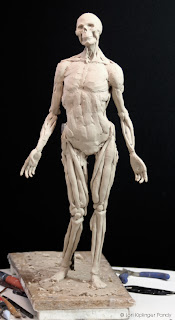Clay is so malleable that it moves constantly while you are working. If you spend more than 30 minutes in any given area you are practically guaranteed that you'll be ripping off that work later when you find mistakes. You must step back and turn your work constantly - no zoning out on one small section because as the clay moves it effects other areas and distortion sets in.
 I'm constantly grabbing my trusty proportional calipers and double checking my measurements. While work like this figure is a figment of my imagination and I have no actual model standing there to reference, I do refer to anatomy books, charts and a life-sized skeleton that I keep in my studio.
I'm constantly grabbing my trusty proportional calipers and double checking my measurements. While work like this figure is a figment of my imagination and I have no actual model standing there to reference, I do refer to anatomy books, charts and a life-sized skeleton that I keep in my studio.
Additionally I will sometimes take measurement of myself as a general guide - if my sculpture is an adult female, that is. Naturally that won't work if I'm sculpting a man.
Here I am taking a measurement of my forearm near my wrist using the larger end of the calipers. I'm working roughly at 1/4 life size (this sculpt is about 16" tall - 16" x 4 = 64" tall, or about 5'4" tall. I'm about 5'5" so I'm a good fit for measuring this particular sculpt). I have the the calipers set to 1/4 scale.
Now I simply flip the calipers around and use the smaller side to measure my sculpture's wrist. I do this often as I work to be sure the proportions are working.
 I'm constantly grabbing my trusty proportional calipers and double checking my measurements. While work like this figure is a figment of my imagination and I have no actual model standing there to reference, I do refer to anatomy books, charts and a life-sized skeleton that I keep in my studio.
I'm constantly grabbing my trusty proportional calipers and double checking my measurements. While work like this figure is a figment of my imagination and I have no actual model standing there to reference, I do refer to anatomy books, charts and a life-sized skeleton that I keep in my studio.Additionally I will sometimes take measurement of myself as a general guide - if my sculpture is an adult female, that is. Naturally that won't work if I'm sculpting a man.
Here I am taking a measurement of my forearm near my wrist using the larger end of the calipers. I'm working roughly at 1/4 life size (this sculpt is about 16" tall - 16" x 4 = 64" tall, or about 5'4" tall. I'm about 5'5" so I'm a good fit for measuring this particular sculpt). I have the the calipers set to 1/4 scale.
Now I simply flip the calipers around and use the smaller side to measure my sculpture's wrist. I do this often as I work to be sure the proportions are working.
























